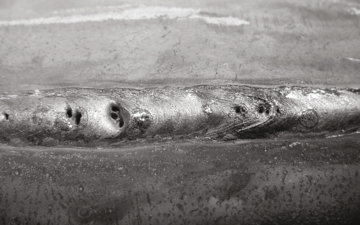What is Porosity in Welding: Typical Sources and Efficient Solutions
Porosity in Welding: Identifying Common Issues and Implementing Best Practices for Avoidance
Porosity in welding is a pervasive issue that typically goes unnoticed up until it triggers substantial troubles with the honesty of welds. In this conversation, we will certainly discover the vital factors contributing to porosity formation, analyze its destructive results on weld efficiency, and review the finest practices that can be adopted to minimize porosity event in welding procedures.
Typical Root Causes Of Porosity

An additional frequent perpetrator behind porosity is the presence of pollutants externally of the base metal, such as oil, grease, or corrosion. When these contaminants are not successfully gotten rid of before welding, they can vaporize and come to be entraped in the weld, triggering flaws. Furthermore, utilizing filthy or damp filler products can introduce pollutants right into the weld, adding to porosity issues. To mitigate these common reasons for porosity, complete cleansing of base steels, proper shielding gas selection, and adherence to ideal welding specifications are necessary techniques in attaining high-quality, porosity-free welds.
Impact of Porosity on Weld Quality

The presence of porosity in welding can considerably compromise the architectural integrity and mechanical residential properties of welded joints. Porosity develops voids within the weld steel, compromising its total strength and load-bearing ability. These voids function as tension focus points, making the weld more at risk to breaking and failing under used lots. Additionally, porosity can minimize the weld's resistance to deterioration and various other environmental variables, further decreasing its durability and efficiency.
One of the primary consequences of porosity is a decrease in the weld's ductility and toughness. Welds with high porosity degrees have a tendency to exhibit reduced effect strength and reduced capacity to deform plastically prior to fracturing. This can be especially worrying in applications where the welded components undergo dynamic or cyclic loading problems. Porosity can restrain the weld's capability to effectively transfer pressures, leading to early weld failing and prospective security risks in vital structures. What is Porosity.
Ideal Practices for Porosity Avoidance
To enhance the architectural stability and quality of bonded joints, what particular measures can be applied to reduce the occurrence of porosity during the welding procedure? Porosity prevention in welding is crucial to make sure the integrity and toughness of the final weld. One efficient technique Discover More Here is appropriate cleansing of the base metal, getting rid of any impurities such as rust, oil, paint, or wetness that can result in gas entrapment. Guaranteeing that the welding tools remains in great problem, with tidy consumables and appropriate gas flow prices, can also considerably lower porosity. Additionally, preserving a steady arc and regulating the welding parameters, such as voltage, present, and take a trip more helpful hints rate, aids develop a consistent weld pool that lessens the threat of gas entrapment. Utilizing the correct welding technique for the particular product being welded, such as adjusting the welding angle and gun placement, can further avoid porosity. Normal inspection of welds and instant removal of any problems identified during the welding process are necessary techniques to stop porosity and produce high-quality welds.
Importance of Correct Welding Techniques
Carrying out proper welding methods is paramount in making certain the structural honesty and quality of welded joints, developing upon the structure of effective porosity prevention procedures. Welding methods directly impact the overall toughness and durability of the bonded framework. One vital facet of appropriate welding methods is maintaining the correct warmth input. Too much warm can result in enhanced porosity due to the entrapment of gases in the weld swimming pool. On the other hand, inadequate heat might lead to incomplete fusion, developing possible weak points in the joint. Additionally, making use of the proper welding parameters, such as voltage, existing, and take a trip speed, is critical for accomplishing sound welds with marginal porosity.
Moreover, the selection of welding process, whether it be MIG, TIG, or stick welding, must straighten with the certain needs of the project to make sure optimum results. Appropriate cleansing and preparation of the base metal, in addition to picking the right filler product, are additionally important elements of skillful welding techniques. By adhering to these finest techniques, welders can minimize the risk of porosity formation and create high-grade, structurally audio welds.

Evaluating and High Quality Control Procedures
Checking procedures are essential to detect and protect against porosity in welding, making sure the strength and durability of the last product. Non-destructive screening techniques such as ultrasonic screening, radiographic testing, and visual assessment are typically used to determine potential flaws like porosity.
Post-weld examinations, on the various other hand, assess the last weld for any kind of issues, consisting of porosity, and validate that it fulfills defined requirements. Carrying out a detailed high quality control plan that includes comprehensive testing treatments and examinations is extremely important to minimizing porosity problems and guaranteeing the overall quality of bonded joints.
Final Thought
In final thought, porosity in welding right here can be a common concern that affects the high quality of welds. By identifying the usual root causes of porosity and executing best techniques for prevention, such as proper welding strategies and testing measures, welders can make certain high top quality and reputable welds. It is necessary to focus on prevention methods to lessen the occurrence of porosity and keep the stability of bonded structures.